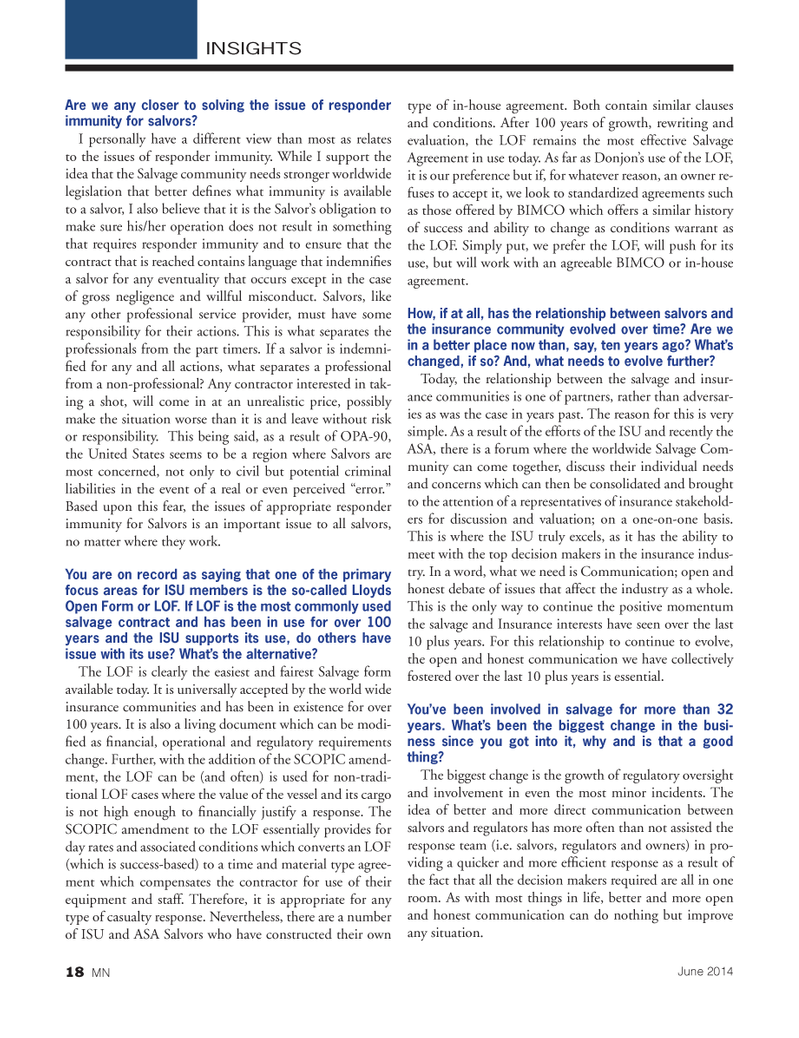
Page 18: of Marine News Magazine (June 2014)
Dredging & Marine Construction
Read this page in Pdf, Flash or Html5 edition of June 2014 Marine News Magazine
Are we any closer to solving the issue of responder immunity for salvors?I personally have a different view than most as relates to the issues of responder immunity. While I support the idea that the Salvage community needs stronger worldwide legislation that better deÞ nes what immunity is available to a salvor, I also believe that it is the SalvorÕs obligation to make sure his/her operation does not result in something that requires responder immunity and to ensure that the contract that is reached contains language that indemniÞ es a salvor for any eventuality that occurs except in the case of gross negligence and willful misconduct. Salvors, like any other professional service provider, must have some responsibility for their actions. This is what separates the professionals from the part timers. If a salvor is indemni- Þ ed for any and all actions, what separates a professional from a non-professional? Any contractor interested in tak- ing a shot, will come in at an unrealistic price, possibly make the situation worse than it is and leave without risk or responsibility. This being said, as a result of OPA-90, the United States seems to be a region where Salvors are most concerned, not only to civil but potential criminal liabilities in the event of a real or even perceived Òerror.Ó Based upon this fear, the issues of appropriate responder immunity for Salvors is an important issue to all salvors, no matter where they work. You are on record as saying that one of the primary focus areas for ISU members is the so-called Lloyds Open Form or LOF. If LOF is the most commonly used salvage contract and has been in use for over 100 years and the ISU supports its use, do others have issue with its use? What?s the alternative? The LOF is clearly the easiest and fairest Salvage form available today. It is universally accepted by the world wide insurance communities and has been in existence for over 100 years. It is also a living document which can be modi- Þ ed as Þ nancial, operational and regulatory requirements change. Further, with the addition of the SCOPIC amend- ment, the LOF can be (and often) is used for non-tradi- tional LOF cases where the value of the vessel and its cargo is not high enough to Þ nancially justify a response. The SCOPIC amendment to the LOF essentially provides for day rates and associated conditions which converts an LOF (which is success-based) to a time and material type agree- ment which compensates the contractor for use of their equipment and staff. Therefore, it is appropriate for any type of casualty response. Nevertheless, there are a number of ISU and ASA Salvors who have constructed their own type of in-house agreement. Both contain similar clauses and conditions. After 100 years of growth, rewriting and evaluation, the LOF remains the most effective Salvage Agreement in use today. As far as DonjonÕs use of the LOF, it is our preference but if, for whatever reason, an owner re- fuses to accept it, we look to standardized agreements such as those offered by BIMCO which offers a similar history of success and ability to change as conditions warrant as the LOF. Simply put, we prefer the LOF, will push for its use, but will work with an agreeable BIMCO or in-house agreement. How, if at all, has the relationship between salvors and the insurance community evolved over time? Are we in a better place now than, say, ten years ago? What?s changed, if so? And, what needs to evolve further? Today, the relationship between the salvage and insur- ance communities is one of partners, rather than adversar- ies as was the case in years past. The reason for this is very simple. As a result of the efforts of the ISU and recently the ASA, there is a forum where the worldwide Salvage Com- munity can come together, discuss their individual needs and concerns which can then be consolidated and brought to the attention of a representatives of insurance stakehold- ers for discussion and valuation; on a one-on-one basis. This is where the ISU truly excels, as it has the ability to meet with the top decision makers in the insurance indus-try. In a word, what we need is Communication; open and honest debate of issues that affect the industry as a whole. This is the only way to continue the positive momentum the salvage and Insurance interests have seen over the last 10 plus years. For this relationship to continue to evolve, the open and honest communication we have collectively fostered over the last 10 plus years is essential. You?ve been involved in salvage for more than 32 years. What?s been the biggest change in the busi- ness since you got into it, why and is that a good thing? The biggest change is the growth of regulatory oversight and involvement in even the most minor incidents. The idea of better and more direct communication between salvors and regulators has more often than not assisted the response team (i.e. salvors, regulators and owners) in pro- viding a quicker and more efÞ cient response as a result of the fact that all the decision makers required are all in one room. As with most things in life, better and more open and honest communication can do nothing but improve any situation.INSIGHTS18 MNJune 2014MN June14 Layout 18-31.indd 18MN June14 Layout 18-31.indd 185/20/2014 10:28:43 AM5/20/2014 10:28:43 AM

 17
17

 19
19
